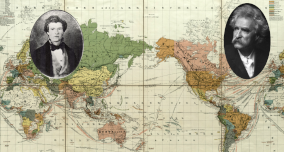Rondout (pronounced "ron doubt"), is situated on the Hudson River, at the mouth of Rondout Creek. Originally a maritime village serving the nearby city of Kingston, New York, Rondout merged with Kingston in 1872. It now includes the Rondout-West Strand Historic District.
https://en.wikipedia.org/wiki/Rondout,_New_York
Mark Twain would have needed to cross the Hudson River on a ferry boat to reach Rondout>
Rondout Ferry Boat Service
August 5, 1752: Abraham Kip and Moses Cantine ran ferries across the Hudson River. They were granted letters of patent giving them exclusive rights to operate. While rates increased every year as per the state’s approval, the operators continued to be protected from any competing service within the documented operating zone.
They used a “periauger” or dugout canoe, “two hollowed-out buttonball logs, with planks bolted between them and a mast, a sail and a bank of oars.”
By 1827 the ferries were operated by James Elmendorf and Peter W. Radcliff. They used a scow with paddle wheels, which was kept in motion by a horse or horses on a conveyor belt. The earliest reference to a steam ferry is in an advertisement in the Kingston Democrat Journal in 1845. The ferry was referred to as the “Kingston Point and Rhinebeck Ferry” with a boat named Knickerboker.
No record of her date of building or dimensions is known but contemporary accounts indicate she was a diminutive side-wheeler of slight power.
October 1, 1851: the Hudson River Railroad opened with a station at Rhinebeck. The ferry service was sold in 1851 and in October of that year the Knickerboker was replaced by the Astoria which was in turn replaced by the Wallabout.
April 24, 1852, the new owner, Charles H. Russell, brought in a new boat, the Rhine. In length: 85 feet 9 inches; breadth: 20 feet 6 inches; depth of hold: 6 feet 9 inches, with a vertical beam engine. On the east side of the river, Shatzell’s Dock was used and Rondout on the west. Trains would not stop at Shatzell’s until December 1. This was the primary route used by the ferries for more than a century. The ferry spent more time in Rondout Creek than in crossing the Hudson River.
The company was incorporated May 7, 1853 as the “Rhinebeck & Kingston Ferry Co.”
July 17, 1860: a new boat, the Lark, was brought into service and would remain the primary boat used by the company until 1881. This boat was a wooden-hulled side-wheeler 92 feet 8 inches long, 23 feet 8 inches wide, with a vertical beam engine. A second boat, the Oriole with an engine from the Rhine, was used occasionally. The Lark was modified in September of 1867 to be 108 feet long, 23.9 feet wide, with a hold of 8 feet. This would most probably be the boat Mark Twain crossed the Hudson River on in 1868, 1870 and 1871 for his lectures in Rondout.
In 1881, the company acquired a new boat that would be in service for most of the company’s history, the Transport; a side-wheel ferry boat built in 1875, with an iron hull, 115 feet long, 26.5 feet wide with a hold of 9.8 feet. Its first official crossing was on August 28, 1881 and ran for 57 years, 3 times as long as the Lark (21 years).
Due to terms of the original incorportation, the company re-incorporated in 1919 as the “Rhinebeck & Kingston Ferry Co. Inc.” The company dissolved in 1944.
With thanks to Carla R. Lesh, Ph.D.
Collections Manager and Digital Archivist
Hudson River Maritime Museum
50 Rondout Landing
Kingston, NY 12401
for an article from the Summer 1988 edition of "Steamboat Bill" on the Kingston-Rhinecliff ferry. History of the Kingston-Rhinecliff Ferry by Donald C. Ringwald originally printed in the Kingston Daily-Freeman.
See also History Alliance of Kingston
